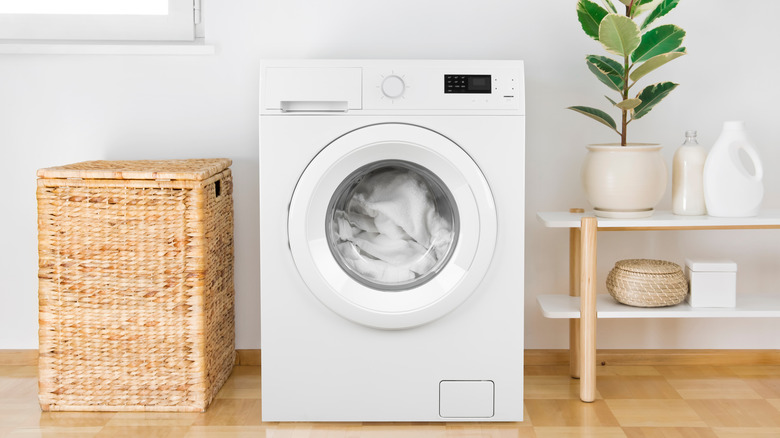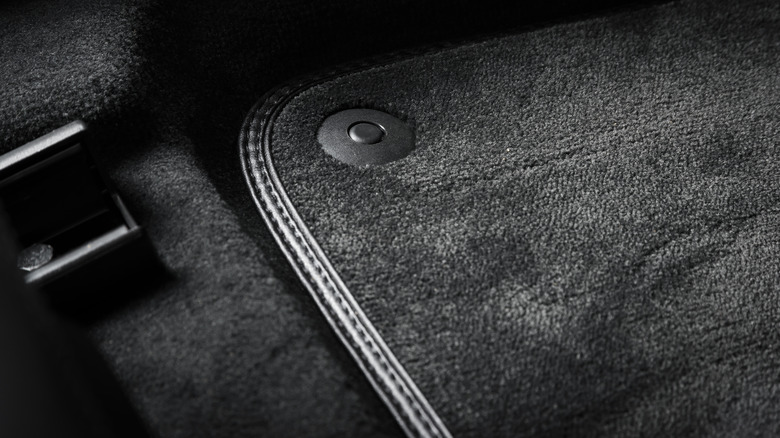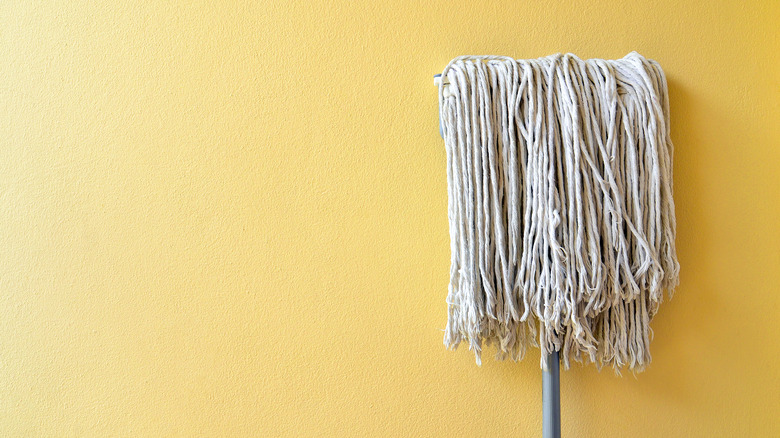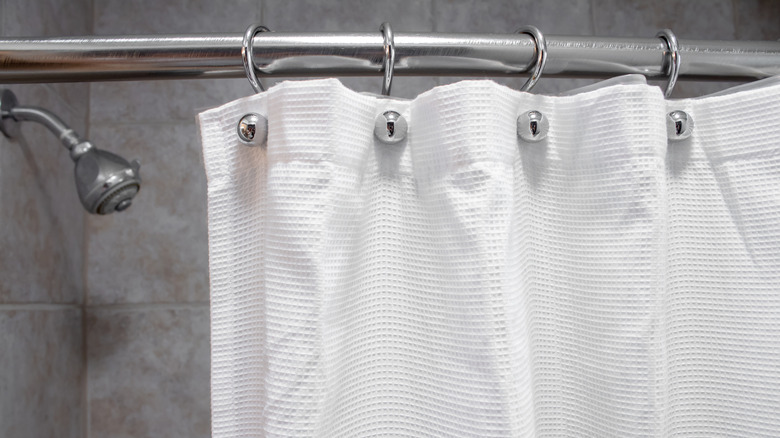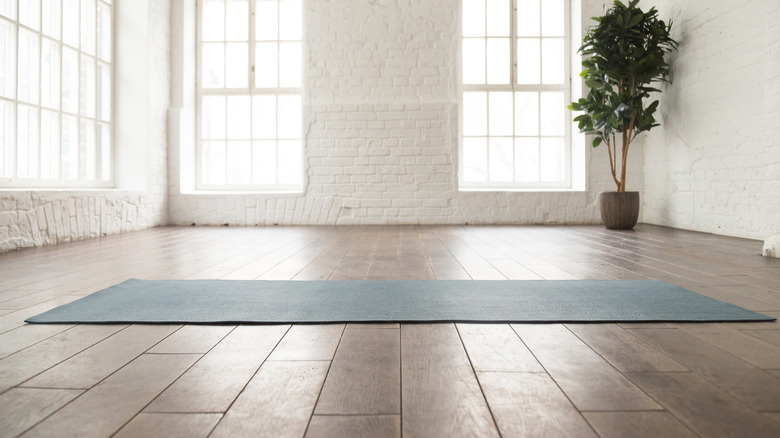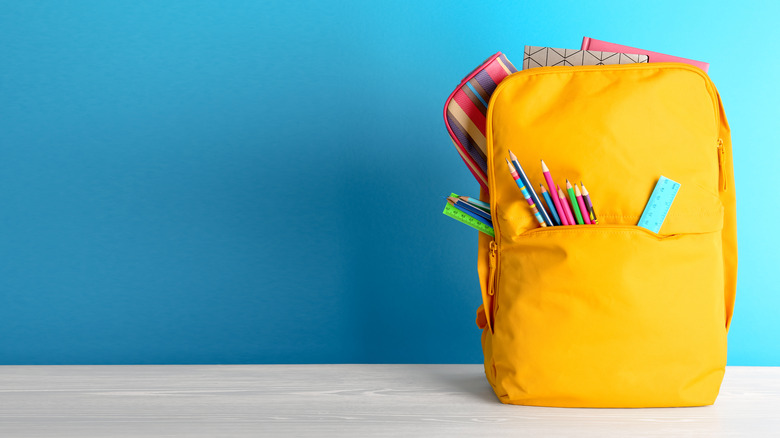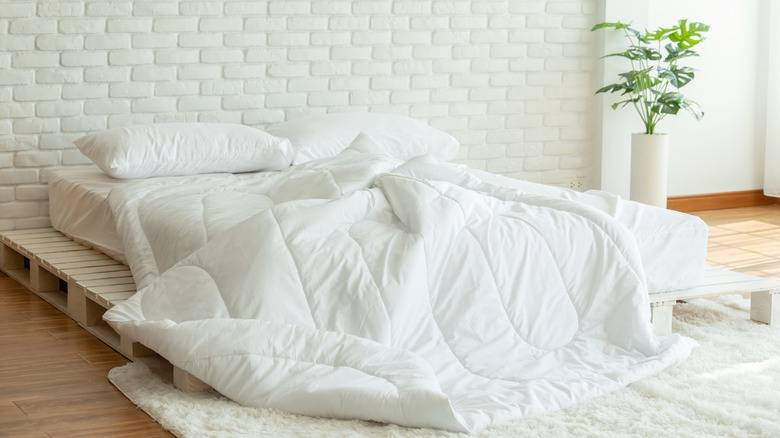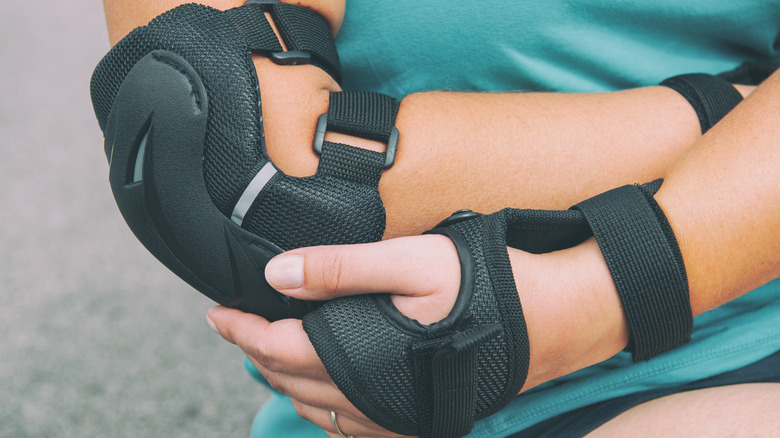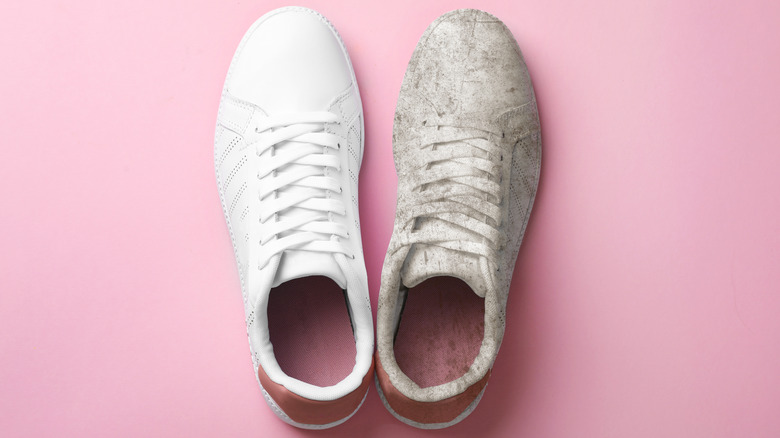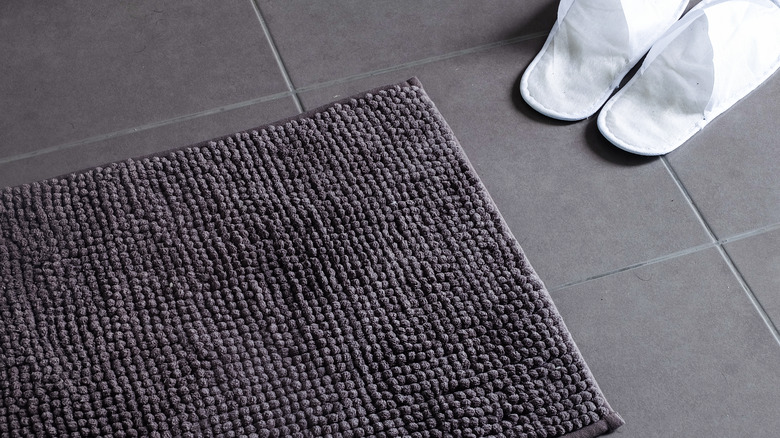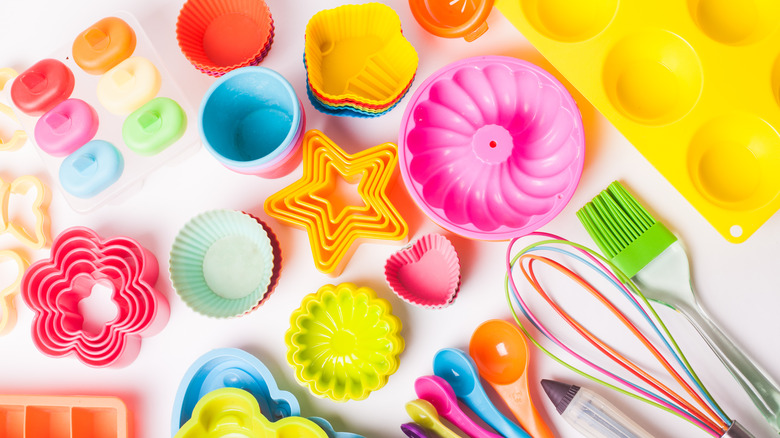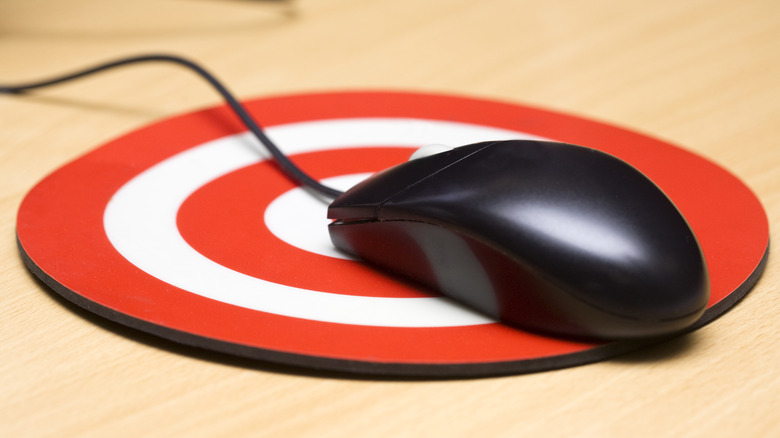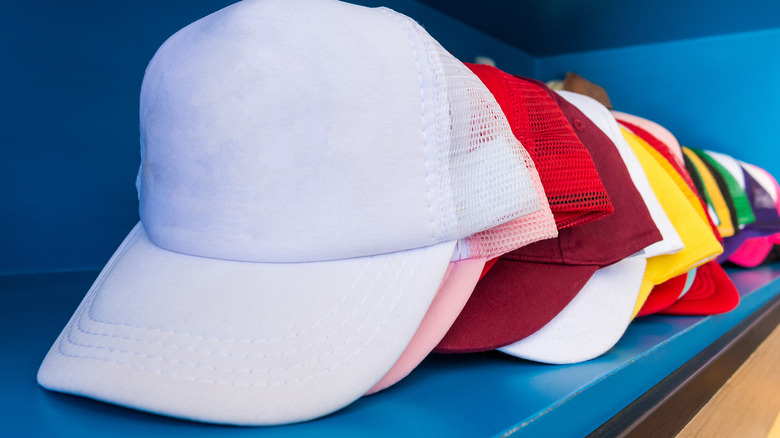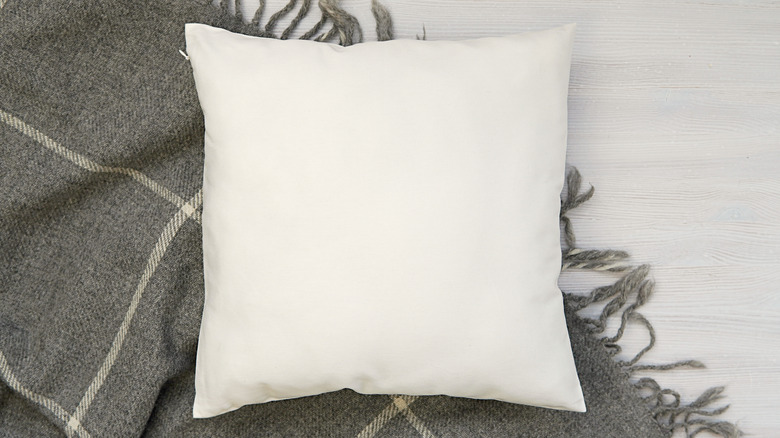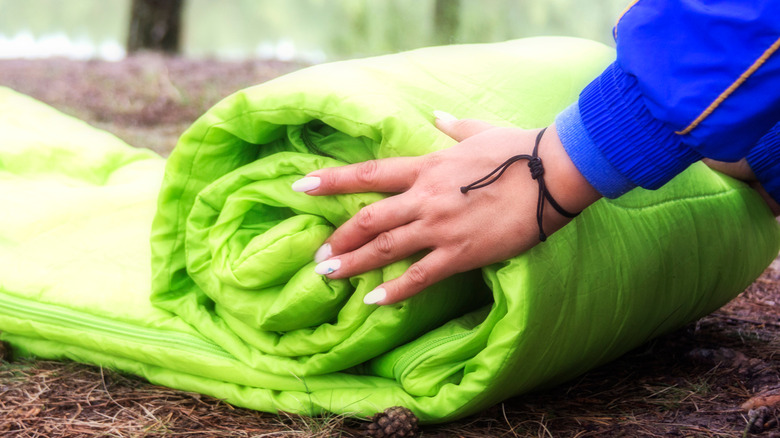Things You Had No Idea You Can Clean In Your Washing Machine
It may not be the most glamorous item in your home, but it's hard to imagine life without your washing machine. Bravely taking on endless piles of dirty laundry, the washing machine's usefulness is so paramount to everyday life that, in a survey of 4,000 adults in the U.K., it was voted the 12th most-important invention ever, coming in higher than the mobile phone, car, steam engine, and Google, according to the Electrolux Group. And perhaps due to their ubiquity and sheer convenience, global sales of washing machines have pretty much been on the rise since 2012, forecast to rise to nearly 170 million units by 2025, according to Statista.
Clearly, the almighty washing machine's not going anywhere. But despite how useful and popular they are already, the vast majority of us are missing some opportunities to make our washing machines even more useful. There's a whole slew of things aside from our clothes and linens that we can clean easily in the washer that we might have struggled to clean before. Let's take a look at things you had no idea you can clean in your washing machine.
Car mats and seat covers
Your car mats and seat covers can get dirty fast, but luckily, your washing machine can get them clean in no time. For your car mats, remove them from your car, and dust them off as much as possible before taking them inside, according to CNET. Then, pretreat them for any stains, and run them through the washing machine on a warm-water, gentle cycle. You can then hang them to air-dry or put them through the dryer, per Your Mechanic.
Seat covers can be trickier because "with all the holes, loops and attachments, it's next to impossible to get the cover removed, let alone figure out how to put it back together," Becky Rapinchuk, founder of Clean Mama, tells HuffPost. She suggests reading the manufacturer's recommendations before beginning and, when removing the seat cover, taking a photo of where the straps and accessories fit together so you can easily reattach it. Then, run the cover through a cold, gentle wash with a mild detergent. Place over a chair to air-dry. Make sure you don't need to use your car seat for up to 24 hours before doing this to allow drying time.
Outdoor climbing equipment
Outdoor climbing equipment can definitely benefit from a washing machine cycle now and again. "I've done a lot of canyoning and caving and abseiling in my time and one of the things that is really important is to keep your ropes and your gear clean," Ash Iredale, content producer for consumer advocacy group Choice, tells ABC Everyday.
Cleaning your ropes is simple if you have a top-loading washing machine. "One of the best ways to clean rope is to chain it up, make it into a loose weave and then popping it into a top-loading washing machine," Iredale says. "Top loading is best because ropes can be quite heavy and they are going to clank around and make a horrible noise in your front-loading washing machine. You want a lot of water when you are cleaning it, to sluice everything out, and top loaders use a lot more water than front loaders."
Be careful about putting equipment with metal accents into the machine, however. "Things with buckles and sharp edges ... can actually do some damage," states Iredale.
Mop heads
Using a washing machine to clean ... something that cleans other things? Yes, the idea is meta, but running a mop head through a washing machine can ensure a cleaner, refreshed mop for your next use. However, it's recommended to use this method with a rayon mop as opposed to a cotton one, as Joe Choplin, the director of operations support for City Wide Franchise, tells Clean Link.
When washing your mop head, use a regular wash cycle, and avoid using fabric softener or bleach because it can damage some mops, such as those made of natural fibers, according to Bill Griffin, president of Cleaning Consultant Services (via Clean Link). It's also important to note that, if machine-drying your mop head, too much heat can damage certain mops because "some of the fibers are more sensitive to higher temperatures than others," Griffin says, causing them to shrink or become brittle. Instead, use low heat or air-dry.
Loofahs and shower curtains
Although your shower is where you get clean, the same can't be said for your loofah or shower curtain. In the case of loofahs, cleaning them regularly is a wise, sanitary move. "Loofahs are interesting. They're used in a wet environment and you hang them up in the shower, which is also a wet environment," says dermatologist Dr. Melissa Piliang, via the Cleveland Clinic. "They don't ever totally dry out, so the loofah is a beautiful breeding ground for bacteria ... That's why it's important to make sure you keep your loofahs clean." Place your loofah in a mesh laundry bag, and wash with a load of towels. Then, air-dry (avoid machine-drying) before putting them back in the shower, per The Spruce.
For your shower curtain, which can often become mildewy, simply take it down, and run it through a warm cycle with either vinegar, laundry detergent, or baking soda, per Merry Maids. Then, hang it back up to dry. If your curtain does have mildew growing, use bleach to remove it; try chlorine bleach on white curtains and oxygen bleach on colored ones.
Yoga mats
If you've been putting in the work to perfect your yoga practice, chances are your mat will need a good clean thanks to sweat stains and grime from the floor. You should actually be doing this weekly by wiping it down, according to Jordan Westra, studio manager at Yoga Vida (via Well+Good). But, running it through the washing machine monthly for a deep clean is also a great idea. Don't use detergent, and then dry it on medium to high heat, suggests Lauren Imparato, founder of I.Am.You yoga (via Well+Good).
It's important, however, to read the manufacturer's instructions for your specific yoga mat because it might become damaged if machine-washed and dried, according to Women's Health. Also, avoid using harsh detergents or running your mat through a spin cycle in order to keep it in good shape. If you're after a machine-washable mat, certain brands, such as Yellow Willow yoga mats, are designed for just that.
Backpacks
With the amount of wear and tear the average backpack endures, especially in the hands of kids, it's not surprising that they need a wash occasionally. Luckily, most backpacks clean up wonderfully in the washing machine. To begin, empty all the pockets and leave them unzipped, making sure to check for anything hidden in corners and remove any metal frames, suggests Mountain Warehouse. Make sure your backpack can fit in the machine, and then either place the backpack in a laundry bag or pillowcase to prevent the straps from getting caught (you can also turn the bag inside out).
Then, using a fragrance- and dye-free detergent, wash the backpack on a gentle cold-water wash. When done, hang it upside down to air-dry. Never run your backpack through a dryer as this could damage the bag. Note that certain materials, like leather, will not fare well in the washing machine, so make sure to check your bag's label before tossing it in the wash.
Duvets and pillows
With bulky items like duvets and pillows, it can be difficult to know how to get them clean. Luckily, running them through a washing machine is entirely viable. When it comes to your duvet, whether it has a down or synthetic filling, using a gentle cycle and cool water should do the trick — provided that your washing machine is big enough, according to Ash Iredale, content producer for consumer advocacy group Choice, via ABC Everyday. The duvet needs ample room in the washing drum or else soil and detergent may not rinse out fully. To dry your duvet, lay it out somewhere to "dry gently and not have weird shapes or lumps from hanging the wrong way," she suggests, such as over a table. Don't place in the direct sun.
For pillows, "it's actually quite important that we wash our pillows more often than we do ... because of the whole issue with dust mites," Iredale says. Regular pillows can be washed in the same manner as your duvet, but, if you use a memory foam or latex pillow, machine-washing isn't recommended. Instead, keep it clean by using a removable, washable pillow liner.
Nylon dog leashes
Anyone who has a four-legged friend knows how quickly their leash can get dirty. However, cleaning them up is quick and easy with your washer. "Some rope or nylon leashes can be safely washed in the washing machine," says Lorraine Rhoads, an environmental biologist at Dogtopia, via Reader's Digest. To do so safely, take your leash, place it in a lingerie bag, and run it through the wash with a few towels. This helps shield your machine from dings and scratches due to metal pieces, according to Chewy vet expert Dr. Jennifer Coates (per RD). Then, hang to air-dry.
Some cleaning products should be avoided in this process. Washing leashes with bleach, fabric softener, or even too much vinegar can potentially harm your pet when it's exposed to the leash again, cause vomiting and diarrhea, according to the ASPCA. In addition, some leashes, such as retractable ones, should never be placed in the washing machine because of the retracting mechanism and should instead be washed by hand.
Children's plush toys
Children's toys can get grubby really fast and become vehicles for germs. Instead, throw soft toys like Teddy bears in the washing machine now and again to keep playtime fun and sanitary. Start by checking the label of the toy, if it has one, for washing instructions, according to The New York Times. Give the toy a critical eye, and use your best judgment: Is it too old or frayed to withstand washing? Also, feel it to see if it has elements inside that could make it unsuitable for a wash (any cardboard, for example).
When you're ready to proceed, place it in a pillowcase. Use a mild detergent and cold water; higher temperatures can melt any glues that attach elements of the toy together. By this same token, leave the toy to air-dry afterward instead of putting it in the dryer. If your child has been sick, however, and the toy can withstand it, wash on hot to kill any lingering germs.
While this method will generally work for plush toys, harder toys like building blocks may not fare as well in the washing machine or dryer: Not only will they make a racket, but hotter temperatures can alter their quality, as LEGO states.
Sports equipment
Tired of smelling those grimy knee and shoulder pads from your weekly hockey game? The washing machine can cover that, too. Sports equipment like knee, shoulder, and elbow pads; shin guards; and some gloves can all benefit from cleaning in the washing machine monthly, according to Reader's Digest. Fasten any velcro straps to make sure there's no snagging, put the items in mesh bags, and then wash on a regular cycle with about half the detergent you'd normally use.
You can then run most gear through the dryer on warm heat, according to Pure Hockey. However, check the manufacturer's instructions for your equipment; if air-drying is preferred, leave the equipment somewhere well-ventilated to dry. You can also use vinegar and the pre-soak feature on your washing machine if your gear is smelling particularly funky. Just make sure you don't use any bleach or bleaching agents, as these can damage the equipment.
Sneakers
Your sneakers see a lot of the world, so giving them a deep clean occasionally is wise. Luckily, shoes of many different kinds can get a great wash in your machine, according to Whirlpool. Generally, shoes made of washable materials like canvas, nylon, polyester, and cotton are all pretty durable and can withstand a wash with detergent. However, delicate shoes or ones made of leather, suede, vinyl, or rubber fare better with special cleaning methods.
Check your shoes' care instructions to make sure they're machine-washable before beginning. If they're good to go, remove the laces and insoles; laces can go in a mesh bag in the machine with your shoes, whereas insoles are better being washed by hand with less water. Remove any excess dirt with a toothbrush or soft brush; place your shoes in a separate mesh bag; and wash with liquid detergent on a cold-water, delicate cycle. Leave them to air-dry for a few days, as they may take longer than you think, and never put them through the dryer because the heat can warp the soles. You can stuff some paper towels or clean cloths inside the shoes as they dry to keep their shape.
Pet beds
Not only can you clean your pet's bed in the washing machine, but you should be doing it pretty frequently — every one or two weeks, according to Kathy Backus, doctor of veterinary medicine at Holistic Veterinary Services, via PetMD. Doing this minimizes the disease-carrying organisms that your pet can bring into your home, which a vacuum won't fully remove. All pet bedding should be laundered on as high a heat as the manufacturer's instructions allow, ideally 140 degrees or above, according to Sally Bloomfield, an honorary professor at the London School of Hygiene and Tropical Medicine.
You can use detergent and chlorine bleach, as Bloomfield suggests, but bear in mind that bleach could seriously harm your pet, per the ASPCA. Instead, opt for a natural detergent and an additional rinse cycle. Then, run the bed through the dryer on high heat (mats or filling should be air-dried).
Note that, before washing, feel the bed to check whether it could have any internal cardboard — in which case, cleaning the bed regularly with an antibacterial wipe could be a better option, according to CNET.
Rubber-backed mats and rugs
If your bath mats or rugs are rubber-backed, you may feel at a loss as to how to clean them without damaging the backing. Well, the good news is that they're entirely washable in the washing machine — although the process differs from washing a non-rubber-backed mat. First, check whether your rug is made of cotton or synthetic fibers and that the rubber backing hasn't crumbled from use, per SFGate. Shake it out outside to remove any excess dirt, and then place it into a top-loading machine with a load of towels. If the machine has an agitator, wrap the mat around it to balance the machine. Make sure not to overfill the washer, and don't wash the mats with your clothes.
Then, run the load through a cold-water, delicate cycle with around half the detergent you'd normally use (and, ideally, one made for delicate items). Avoid placing your rubber-backed mat in the dryer, as high heats can cause the rubber to crumble and overall shorten the life of your product. Instead, hang it on a drying rack or a clothesline to air-dry.
Silicon kitchen tools
This one might raise an eyebrow, but, if your house doesn't have a dishwasher, getting into the nooks and crannies of intricately shaped silicon kitchen tools can be a nightmare. That's where your washing machine comes in. You can even throw them in with your regular laundry load, according to The Spruce. Just place them in a mesh laundry bag to keep them together, and wash them with hot or warm water and a heavy-duty detergent, which will help break down any lingering food oils. Use a gentle spin cycle to stop any distortion of the equipment.
If you have a lot of silicon tools that need washing, however, or if you want to keep your kitchen equipment separate from your finest garments, you can wash them alone. You can also clean your oven mitts, too, while you're at it! Just make sure to check the manufacturer's instructions before doing so.
Oven mitts and pot holders
These everyday kitchen essentials can get pretty gross. Most of them are covered in stains and food residue, making them a prime candidate for a thorough cleaning. There is no reason to leave last Thanksgiving's leftovers on your pot holders. You might not have thought of it, but by using your washing machine, you can effortlessly restore these kitchen companions to their former glory.
The great news is that there typically aren't any special rules that make washing oven mitts and pot holders any different from other fabrics. However, be sure to check the care label on yours for any specific instructions, just in case. Most are machine-washable, but it's always wise to double-check. Once you've confirmed their washability, remove any loose parts, like silicone grips, to prevent potential damage. Then, you can treat them much like you would a dirty apron or tablecloth. You can use a stain buster to pretreat any particularly bad spots before placing the mitts and pot holders into the washing machine. You can wash them alone if they are particularly dirty, or pop them in with the rest of your kitchen linens if they're not.
Adding a mild detergent specifically designed for delicate fabrics can help remove grease and grime effectively. Select a gentle or delicate cycle with a cold water setting to protect the fabric's integrity. Once the cycle is complete, remove your freshly cleaned oven mitts and pot holders and allow them to air dry.
Mousepads
These often-neglected computer accessories collect dirt, dust, and oils from our hands, making them a perfect candidate for a refreshing clean. So, why not let your washing machine do the hard work for you? While most mouse pads are machine-washable, some may have special considerations or materials that require a different approach. Check the manufacturer's instructions for any cleaning guidelines. If yours is okay to machine wash, start by giving your mouse pad a quick pre-treatment. If there are any visible stains or spots, you can gently spot-clean them using a mild detergent or stain remover. Simply dab the solution on with a cloth and allow it to sit for a few minutes before proceeding to the washing machine.
For the wash cycle, select a gentle or delicate setting and use cold water. Adding a small amount of mild detergent will help break down dirt and oils. Once the wash cycle is complete, rinse off the mouse pad in the sink if there is any detergent residue. Press out excess water gently, being careful not to wring or twist it, as this can distort its shape. To aid in the drying process, you can gently pat the mouse pad between a folded towel to absorb excess moisture. Finally, allow your mouse pad to air dry completely before returning it to your workspace. Placing it flat on a clean surface, preferably away from direct sunlight or heat sources, will help it regain its original shape and texture.
Baseball caps
Hats keep us shaded from the sun but are often caked with sweat, and dirt can easily start smelling quite nasty. The good news is you can wash your favorite baseball caps and bring them back to their former glory. Remember, most hats can withstand a gentle machine wash, but it's always best to check the care label for any specific instructions, just in case. For example, older hats tend to have cardboard in them and can't be machine-washed, but newer ones with plastic-based brims are fine.
To protect the shape and structure of your caps, you can place them inside a pillowcase or a mesh laundry bag to minimize agitation. You should also wash them either alone or with only one or two other things to prevent denting or other damage. Opt for a gentle cycle with cold water and use a mild detergent. Be careful with bleach, as even white caps can have colored elements that might get ruined. Once the wash cycle is complete, remove your caps from the washing machine and inspect them. If necessary, reshape the caps by hand, gently stretching and molding them back into their original form. It's crucial to let them air dry naturally to maintain their shape and prevent shrinkage.
Cushion covers
Your cushion covers likely see a lot of action! They accumulate dust, pet hair, oils from our skin, and food and drink spills. While you can steam-clean couch cushions if they aren't removable, most couches have zip-off cushion covers that are easy to just pop in the washer. If you aren't sure if your cushions are a candidate, check the tags or look online. Many brand websites have a care section that will tell you either way. The same can be said for most throw pillows, too. You would be surprised how many have covers that can be unzipped and popped in the wash.
If yours are washing machine safe, it's best to give them a good shake outside before putting them in the machine. Wash them alone and do not mix them with other laundry, as the textures are different and sometimes the zippers on the cushions can snag other fabrics. Wash them on delicate and use cold water to avoid any shrinkage or damage to the covers' shape. It's best to let them air dry, but if you do put them in the dryer, don't run them for the full cycle. Take them out almost dry, stretch them to help protect their shape, and lay them flat to finish drying.
Tennis balls
Anyone with an enthusiastic dog knows that their favorite tennis ball easily gets dirty. It's covered in dog hair, drool, dirt, and one knows what else from the latest game of fetch in the backyard. Even if you use tennis balls for tennis or as a stretching aid, your washing machine can help make them good as new. While it's unlikely the tennis balls will damage your washing machine, it's a good idea to put them in with a load of towels to prevent them from bouncing around too much. This extra bit of substance can also help the washing machine remain more balanced.
Add a small amount of mild detergent to the washing machine, using the delicate cycle with cold water. If you are washing your dog's tennis balls, carefully consider the ingredients of the detergent you choose, as it is possible your pet might ingest some residue. It's best to choose a non-toxic one or simply run the cycle without soap. You can dry them in the dryer as normal as they shouldn't cause harm to the machine. In fact, they even function a bit like dryer balls, helping other items dry more quickly.
Sleeping bags
Sleeping bags can get pretty dirty and smelly, especially if you just shove them back into their case after each camping trip. They can accumulate dirt and sweat and really cling to odors over time. Luckily, your washing machine can help you restore them to their clean and comfortable state.
Different sleeping bags may have specific cleaning requirements based on their materials and construction. Always check the tag on your sleeping bag to confirm it is machine-washable. To begin, unzip your sleeping bag completely and empty any pockets it might have. Shake it out outside to remove loose dirt or debris before loading it into the washing machine. It's best to wash your sleeping bag separately from all other laundry to avoid potential damage and ensure a thorough clean. Once unzipped, you can treat your sleeping back like any other large duvet. Choose the delicate cycle with cold water to protect the integrity of the sleeping bag's materials. If possible, avoid settings with a high spin cycle at the end because the speed might tear or snag the bag's delicate outside.
